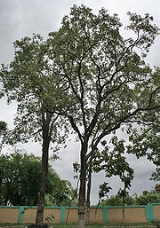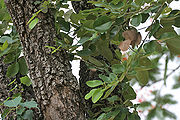
Pterocarpus santalinus
Encyclopedia
- "Red Sandalwood" redirects here. See also: AlgumAlgum-Biblical Reference:According to the Book of First Kings , and the Second Book of Chronicles , it was used, together with cedar and pine, in the construction of Solomon's Temple including the crafting of musical instruments for use in the Temple...
.
Pterocarpus santalinus ( (raktachandana), ( (ciwappuccantanam); Red Sanders or Red Sandalwood) is a species of Pterocarpus
Pterocarpus
Pterocarpus is a pantropical genus of trees in the family Fabaceae, most of which yield valuable timber traded as padauk ; other common names are mukwa or narra...
native to India
India
India , officially the Republic of India , is a country in South Asia. It is the seventh-largest country by geographical area, the second-most populous country with over 1.2 billion people, and the most populous democracy in the world...
. It is only found in south India in Kadapa
Kadapa
Kadapa , formerly Cuddapah, is a city in the south-central part of Andhra Pradesh, India . The city's name originated from the Telugu word "Gadapa" meaning threshold or gate...
and Chittoor
Chittoor
Chittoor also known as Chittur, is a City and municipal corporation located in the Chittoor District of Andhra Pradesh, India. It is conveniently located on major highways linking the cities of Bangalore and Chennai....
on the Tamil Nadu and Andhra Pradesh border.

Tree
A tree is a perennial woody plant. It is most often defined as a woody plant that has many secondary branches supported clear of the ground on a single main stem or trunk with clear apical dominance. A minimum height specification at maturity is cited by some authors, varying from 3 m to...
growing to 8 m tall with a trunk 50–150 cm diameter. It is fast-growing when young, reaching 5 m tall in three years even on degraded soils. It is not frost tolerant, being killed by temperatures of −1 °C. The leaves
Leaf
A leaf is an organ of a vascular plant, as defined in botanical terms, and in particular in plant morphology. Foliage is a mass noun that refers to leaves as a feature of plants....
are alternate, 3–9 cm long, trifoliate with three leaflets. The flower
Flower
A flower, sometimes known as a bloom or blossom, is the reproductive structure found in flowering plants . The biological function of a flower is to effect reproduction, usually by providing a mechanism for the union of sperm with eggs...
s are produced in short raceme
Raceme
A raceme is a type of inflorescence that is unbranched and indeterminate and bears pedicellate flowers — flowers having short floral stalks called pedicels — along the axis. In botany, axis means a shoot, in this case one bearing the flowers. In a raceme, the oldest flowers are borne...
s. The fruit
Fruit
In broad terms, a fruit is a structure of a plant that contains its seeds.The term has different meanings dependent on context. In non-technical usage, such as food preparation, fruit normally means the fleshy seed-associated structures of certain plants that are sweet and edible in the raw state,...
is a pod 6–9 cm long containing one or two seed
Seed
A seed is a small embryonic plant enclosed in a covering called the seed coat, usually with some stored food. It is the product of the ripened ovule of gymnosperm and angiosperm plants which occurs after fertilization and some growth within the mother plant...
s.
Uses
The woodWood
Wood is a hard, fibrous tissue found in many trees. It has been used for hundreds of thousands of years for both fuel and as a construction material. It is an organic material, a natural composite of cellulose fibers embedded in a matrix of lignin which resists compression...
has historically been valued in China
China
Chinese civilization may refer to:* China for more general discussion of the country.* Chinese culture* Greater China, the transnational community of ethnic Chinese.* History of China* Sinosphere, the area historically affected by Chinese culture...
, particularly during the Ming
Ming Dynasty
The Ming Dynasty, also Empire of the Great Ming, was the ruling dynasty of China from 1368 to 1644, following the collapse of the Mongol-led Yuan Dynasty. The Ming, "one of the greatest eras of orderly government and social stability in human history", was the last dynasty in China ruled by ethnic...
and Qing
Qing Dynasty
The Qing Dynasty was the last dynasty of China, ruling from 1644 to 1912 with a brief, abortive restoration in 1917. It was preceded by the Ming Dynasty and followed by the Republic of China....
periods, referred to in Chinese as zitan (紫檀) and spelt tzu-t'an by earlier western authors such Gustav Ecke, who introduced classical Chinese furniture to the west. It has been one of the most prized woods for millennia. King Solomon was given tribute logs of Almug in Sanskrit valgu, valgum by the Queen of Sheba Due to its slow growth and rarity, furniture
Furniture
Furniture is the mass noun for the movable objects intended to support various human activities such as seating and sleeping in beds, to hold objects at a convenient height for work using horizontal surfaces above the ground, or to store things...
made from zitan is difficult to find and can be expensive . Between the 17th and 19th centuries in China the rarity of this wood led to the reservation of zitan furniture for the Qing dynasty
Qing Dynasty
The Qing Dynasty was the last dynasty of China, ruling from 1644 to 1912 with a brief, abortive restoration in 1917. It was preceded by the Ming Dynasty and followed by the Republic of China....
imperial household. Chandan, the Indian word for Red Sandalwood which is Tzu-t’an, are linked by etymology. The word tan in Chinese is a perfect homonym of “tan”, meaning cinnabar, vermillion and the cognition is suggested by the interchange of chan for oriflamme, the vermilion ensign of the ancients. Chinese traders would have been familiar with Chandan. Tzu-t’an then is the ancient Chinese interpretation for the Indian word chandan for red sandalwood.
The other form of zitan is from the species Dalbergia luovelii, Dalbergia maritima
Dalbergia maritima
Dalbergia maritima is a species of legume in the Fabaceae family.It is found only in Madagascar.It is threatened by habitat loss due to the over-consumption of its species.-Source:* Du Puy, D. 1998. . Downloaded on 19 July 2007....
, and Dalbergia normandi, all similar species named in trade as bois de rose or violet rosewood which when cut are bright crimson purple changing to dark purple again. It has a fragrant scent when worked.

